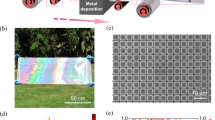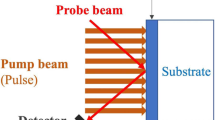Abstract
In principle, multiwavelength radiation thermometry allows one to correctly measure the temperature of surfaces of unknown and varying surface emissivity. Unfortunately, none of the practical realizations proposed in the past proved to be sufficiently reliable because of a strong influence of the errors arising from incorrect modeling of the emissivity and of the limited number of operating wavelengths. The use of array detectors allows a high degree of flexibility both in terms of number and spectral position of the working wavelength bands. In the case of applications at high temperatures, i.e., near 2000 \(^{\circ }\)C or above, an analysis of the theoretical measuring principles of multiwavelength thermometry, suggests the opportunity of investigating the possible advantages in extending the operating wavelengths toward the ultraviolet region. To this purpose, a simulation program was developed which allows investigation of the effect of different influencing parameters. This paper presents a brief theoretical introduction and practical analysis of the method. The best choices are derived in terms of the different influencing parameters and data relative to the simulation of both real materials and fictitious emissivity curves and have been studied and analyzed with different emissivity models to check the robustness of the method.









Similar content being viewed by others
References
J.L. Gardner, T.P. Jones, M.R. Davies, High Temp. High Press. 13, 459 (1981)
J.F. Babelot, M. Hoch, High Temp. High Press. 22, 409 (1990)
G. Ruffino, Z.H. Chu, S.G. Kang, J.G. Dai, in Temperature: Its Measurement and Control in Science and Industry, vol. 6, part 2, ed. by J.F. Schooley (AIP, New York, 1992), pp. 807–811
M. Battuello, T. Ricolfi, L. Wang, in Proceedings TEMPMEKO ’93, 5th International Symposium on Temperature and Thermal Measurements in Industry and Science, vol. 5, ed. by F. Bernhard (IMEKO/Tech-Market, Prague, 1993), pp. 150–155
P.B. Coates, Metrologia 17, 103 (1981)
P.B. Coates, High Temp. High Press. 20, 443 (1988)
M.A. Khan, C. Allemand, T.W. Eagar, Rev. Sci. Instrum. 62, 403 (1991)
G. Neuer, L. Fiessler, M. Groll, E. Schreiber, in Temperature: Its Measurement and Control in Science and Industry, vol. 6, part 2, ed. by J.F. Schooley (AIP, New York, 1992), pp. 787–789
“Thermal Radiative Properties - Metallic Elements and Alloys”, in Thermophysical Properties of Matter, The TPRC Data Series, vol. 7, ed. by Y.S. Touloukian (IFI/Plenum, New York, 1970), pp. 654–689, 776–827
Acknowledgments
The EMRP is jointly funded by the EMRP participating countries within EURAMET and the European Union. The research within this EURAMET joint research project receives funding from the European Community’s Seventh Framework Programme, ERA-NET Plus, under Grant Agreement No. 217257.
Author information
Authors and Affiliations
Corresponding author
Rights and permissions
About this article
Cite this article
Girard, F., Battuello, M. & Florio, M. Multiwavelength Thermometry at High Temperature: Why It is Advantageous to Work in the Ultraviolet. Int J Thermophys 35, 1401–1413 (2014). https://doi.org/10.1007/s10765-014-1678-1
Received:
Accepted:
Published:
Issue Date:
DOI: https://doi.org/10.1007/s10765-014-1678-1




